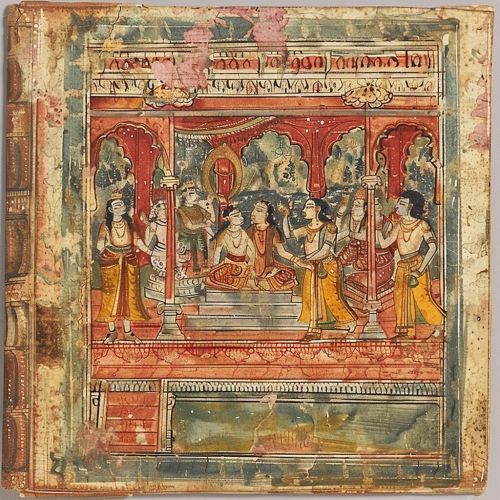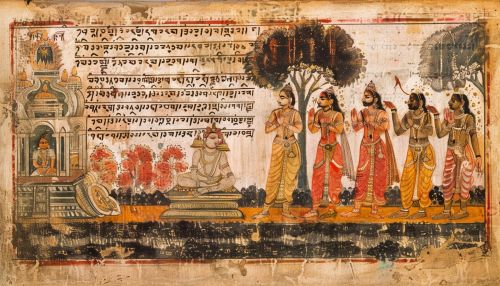Samhita: Difference between revisions
(Created page with "== Introduction == The term "Samhita" refers to a collection of ancient Indian texts that form the foundational layer of the Vedas, which are the oldest sacred scriptures of Hinduism. The Samhitas are primarily composed in Sanskrit and are considered to be the earliest and most authoritative texts in the Vedic literature. These texts are primarily composed of hymns, mantras, and prayers that were used in various rituals and ceremonies. The Samhitas are divided into four...") |
No edit summary |
||
| Line 73: | Line 73: | ||
[[Category:Indian literature]] | [[Category:Indian literature]] | ||
[[Image:Detail-91699.jpg|thumb|center|Ancient Indian manuscript with Sanskrit text, depicting a page from the Samhita.|class=only_on_mobile]] | |||
[[Image:Detail-91700.jpg|thumb|center|Ancient Indian manuscript with Sanskrit text, depicting a page from the Samhita.|class=only_on_desktop]] | |||
Latest revision as of 01:41, 20 June 2024
Introduction
The term "Samhita" refers to a collection of ancient Indian texts that form the foundational layer of the Vedas, which are the oldest sacred scriptures of Hinduism. The Samhitas are primarily composed in Sanskrit and are considered to be the earliest and most authoritative texts in the Vedic literature. These texts are primarily composed of hymns, mantras, and prayers that were used in various rituals and ceremonies. The Samhitas are divided into four collections: the Rigveda, the Samaveda, the Yajurveda, and the Atharvaveda.
Structure and Content of the Samhitas
The Samhitas are structured as compilations of hymns and mantras. Each of the four Vedas has its own Samhita, which serves as the core text. The content of these texts varies, reflecting the different purposes and rituals they were intended to serve.
Rigveda Samhita
The Rigveda Samhita is the oldest of the four Vedas and consists of 1,028 hymns (suktas) divided into ten books (mandalas). These hymns are primarily addressed to various deities such as Agni, Indra, and Soma, and are used in rituals and sacrifices. The Rigveda is notable for its poetic and philosophical content, which includes cosmological hymns and hymns of creation.
Samaveda Samhita
The Samaveda Samhita is a collection of melodies (saman) and chants that are used in the Soma sacrifice. It consists of 1,549 verses, most of which are derived from the Rigveda. The Samaveda is unique in that it focuses on the musical and melodic aspects of the hymns, and its recitation is considered to be an essential part of Vedic rituals.
Yajurveda Samhita
The Yajurveda Samhita is divided into two main recensions: the Shukla (White) Yajurveda and the Krishna (Black) Yajurveda. This Veda is primarily concerned with the procedures and formulas for performing various rituals and sacrifices. It contains both prose and verse, and its content is more practical and ritualistic compared to the Rigveda and Samaveda.
Atharvaveda Samhita
The Atharvaveda Samhita is a collection of hymns, spells, and incantations that are used for various purposes, including healing, protection, and magic. It consists of 730 hymns divided into 20 books. The Atharvaveda is distinct from the other three Vedas in that it includes a significant amount of material related to everyday life and practical concerns.
Historical Context and Significance
The Samhitas were composed over a long period, beginning around 1500 BCE and continuing for several centuries. They represent the earliest phase of Vedic literature and provide valuable insights into the religious, social, and cultural life of ancient India. The hymns and mantras of the Samhitas were transmitted orally for generations before being written down, and they have been preserved with remarkable accuracy.
The Samhitas are considered to be apauruṣeya, meaning "not of human agency," and are believed to have been revealed to the ancient sages (rishis) through divine inspiration. This belief underscores the sacred and authoritative status of these texts within Hinduism.
Rituals and Practices
The Samhitas play a central role in Vedic rituals and ceremonies. The hymns and mantras are recited during various rituals, including the Agnihotra, Somayajna, and Ashvamedha. These rituals are performed to invoke the blessings of the deities, ensure prosperity, and maintain cosmic order (rita).
The recitation of the Samhitas is governed by strict rules of pronunciation and intonation, known as Shiksha. The correct recitation is believed to be crucial for the efficacy of the rituals, and specialized priests (hotri, udgatri, adhvaryu, and brahman) are trained in the precise chanting of these texts.
Philosophical Themes
The Samhitas contain a rich tapestry of philosophical themes and ideas. While primarily focused on ritual and worship, they also explore questions related to the nature of the universe, the origins of creation, and the relationship between humans and the divine.
One of the most famous hymns in the Rigveda is the Nasadiya Sukta, which contemplates the origins of the cosmos and the mystery of creation. This hymn reflects the speculative and philosophical nature of the Vedic tradition.
Influence and Legacy
The Samhitas have had a profound influence on the development of Indian religion, philosophy, and culture. They form the foundation of the Vedic tradition, which has continued to shape Hindu thought and practice for millennia. The later layers of Vedic literature, including the Brahmanas, Aranyakas, and Upanishads, build upon the hymns and mantras of the Samhitas.
The Samhitas have also influenced other religious traditions in India, including Buddhism and Jainism. The emphasis on ritual, the use of mantras, and the philosophical inquiries found in the Samhitas have left an indelible mark on the spiritual landscape of the Indian subcontinent.
Preservation and Transmission
The preservation and transmission of the Samhitas have been a remarkable feat of oral tradition. The texts were memorized and passed down through generations of priests and scholars using elaborate mnemonic techniques. This oral tradition ensured the accuracy and integrity of the texts over millennia.
In addition to the oral tradition, the Samhitas were eventually written down in various scripts, including Devanagari, Grantha, and Sharada. Manuscripts of the Samhitas have been discovered in different parts of India, attesting to their widespread use and reverence.
Modern Relevance
In contemporary times, the Samhitas continue to be studied and revered by scholars, practitioners, and devotees. They are an essential part of the curriculum in traditional Vedic schools (gurukulas) and are recited during various religious ceremonies and festivals.
The philosophical and spiritual insights of the Samhitas remain relevant, offering timeless wisdom and guidance. The hymns and mantras are also used in modern practices such as yoga and meditation, reflecting their enduring significance.
See Also
Categories


